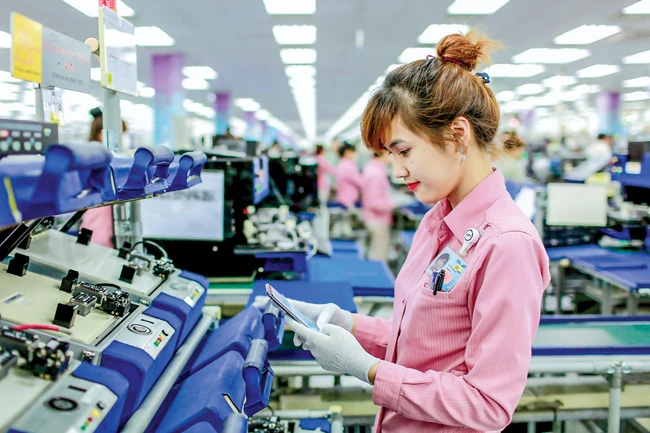
However, it is still to be seen whether more FDI inflow will once again help in reviving the economy, and boost businesses and production that have been seriously impacted by the Covid-19 pandemic.
New FDI inflow
In a report published in mid-January 2021, the Economist Intelligence Unit (EIU) of the ‘The Economist’ magazine, stated that Vietnam has emerged as an attractive Foreign Direct Investment destination in Asia, surpassing India and China. According to the EIU, Vietnam has beat both China and India to become the next manufacturing hub in Asia. Factors that have helped Vietnam to compete with other very strong manufacturing countries is a cheaper labor force, many free trade agreements (FTAs), and various incentives offered by the Government of Vietnam. Foreign enterprises want to invest in production of high-tech products, and these factors have proved very favorable for investors.
EIU's comment was made in the context of Foxconn Technology Co. Ltd. (Taiwan) was awarded a license to build a USD 270 million laptop and tablet factory in Bac Giang province. According to a representative of Foxconn, by the end of 2020, this company had invested USD 1.5 bn in Vietnam and plans to increase investment capital by USD 700 mn and employ 10,000 more local workers in 2021. Foxconn has also set a target to invest USD 1.3 bn in Thanh Hoa province.
Technology is not the only field drawing more FDI, but now many real estate enterprises also see the Vietnamese market as a safe investment destination. For example, the Logos Property Group of Australia has invested USD 350 mn in a joint venture for logistics real estate to penetrate the Vietnamese market, and the Asian warehouse giant GLP is planning a partnership with SEA Logistic Partners Vietnam to launch a USD 1.5 bn joint venture in Vietnam. Mirae Asset Daewoo Co. and Naver Corporation of South Korea has also invested USD 37 mn to build a warehouse in LogisValley hub in Bac Ninh province.
Development of billion-dollar investment projects even as the Covid-19 pandemic continues to rage across the world is still complicated, but is seemingly opening up prospects of a new wave of FDI pouring into Vietnam with immensely big players. This has been further strengthened by Vietnam signing many new FTAs in 2020, as well as Vietnam offering attractive and concrete policies for FDI inflow.
In early 2021, the amended Investment Law officially took effect, supplementing regulations that now allow the Government to offer special incentives to create attractive and timely policies to attract more capital flow. FDI is moving rapidly now and accordingly it is allowed to apply for upto 50% more incentives. The Law also supplements industries and occupations with investment incentives to ensure selective and quality foreign investment, such as innovation technology; producing of goods; and providing services for value chains.
Too early for optimism
FDI still needs time for refinement and evaluation. We cannot just look at the capital scale of FDI projects and make a judgement, but we also have to look at the effectiveness of FDI inflow into the economy. This is not without a basis, as a recent report by the Ministry of Finance showed that in 2019 upto 55% of FDI enterprises in Vietnam reported huge losses. The losses amounted to VND 131,445 bn. This is what economists term as a strange phenomenon, but such a strange occurrence is not entirely new but has been going on for many years. This is also the reason why the Government was forced to promulgate Decree 132/2020/ND-CP, which regulates tax for enterprise transactions, and is considered a strong measure to prevent price transfer in FDI enterprises.
According to Asso.Prof. Dr. Le Xuan Ba, former Director of Central Institute for Economic Research (CIEM), with the signing of FTAs, more FDI inflow will increase into Vietnam. However, this will also raise both benefits and challenges. If there is no selective process, there will be an increase in more risk for Vietnamese enterprises and they stand to eventually lag behind.
Looking at the current import-export structure of Vietnam, it is easy to see that the main exports still come under the FDI sector. By 2020, materials for production are estimated to account for 93.6% of the total import turnover of goods, reaching USD 245.6 bn; while consumer goods accounted for only USD 16.8 bn, down by 3.8%. This proves that we are heavily dependent on imported materials, and the added value makes our product value low. In addition, with many FTAs, Vietnam is in danger of becoming a transshipment place for goods from neighboring countries, importing finished goods and semi-finished products from abroad and then faking origin of another country.
In order to receive high-quality FDI inflow, we need strong institutional reforms, improve a more open investment and business environment, and meet the strict conditions of technical, technology and environmental standards. Sadly, in the report on "Business Environment Reform and Competitiveness: Results, Lessons and Directions 2021-2025" recently published by CIEM, the above requirements are still a bottleneck.
The FDI inflow early in 2021 has brought a ray of hope for Vietnam to revive its economy which has suffered under the Covid-19 pandemic. However, whether this FDI inflow will help in boosting the economy is yet to be seen and felt. Maybe it is too early to be optimistic about it and it is best to wait and watch in coming months.




















